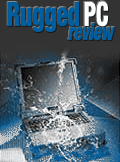Hewlett Packard's New iPAQs
A first look at HP's massive announcement:
Something for everyone, and the best PDA ever.
(Pen Computing Magazine News, July 26, 2004)
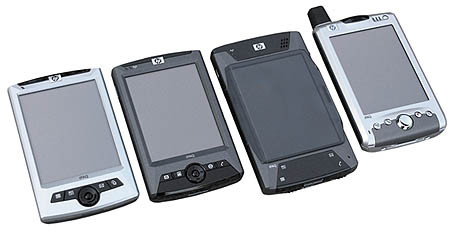
Hewlett Packard has announced no less than four new lines of iPAQs, essentially replacing almost its entire iPAQ lineup with a new one. These machines are not only brand-new and exciting, they also draw a much clearer line between home and business devices. From now on, only the business-oriented machines will be called Pocket PCs. Those marketed to consumers will be called Mobile Media Companions. That's to emphasize their near seamless integration into the rapidly emerging home media networks that combine the internet, personal computing, gaming, music, and all sorts of entertainment into one cohesive system. HP's new iPAQ lineup consists of:
- 1) Two new "Mobile Media Companions," the rz1700 Series and the rx3000 Series. The 1700 is the new entry level whereas the 3000 Series is much more full-featured, even offering a model that has a rather built-in 1.3 megapixel digital camera.
- 2) A new high-end business machine in the hx4700 Series with a blindingly fast 624MHz processor, a gorgeous 480x640 4-inch display and, a first in Pocket PCs, a touch pad.
- 3) The hotly anticipated h6315 Pocket PC phone, easily the most advanced, and most compact, Pocket PC phone to-date.
With the exception of the h6300 Pocket PC Phone, all of the new iPAQs sport entirely new design and styling. Longtime iPAQ users may hardly recognize them as iPAQs at first sight. After all these years of a rather unique "iPAQ look," it will be interesting to see how the public will react to the new designs as the new models do not look as boldly progressive and unique as older iPAQs. Here's a look at the new iPAQs:
Low end: HP iPAQ rz1700 Mobile Media Companion
iPAQ rz1700 is HP's new low-end offering. It has a streamlined new design and a footprint of just 4.5 x 2.75 inches. It's just over half an inch thick and weighs only 4.3 ounces. That's roughly the same as the old "little" iPAQ, the 1900 Series. Compared with the older 1900 Series, the 1700 is a more angular design. The 1900's curves and subtle, smooth lines have given way to a heavier, sturdier look. This is accentuated by the new model's gray backside compared to the rounded, silvery bottom. Like the entire new lineup, the 1700 sports a little HP logo, silver on a black circle in a small little badge. Unlike the 1900 which had a replaceable battery pack, the 1700's is built-in and cannot be replaced. It does, however, have a slightly higher capacity: 1,000 mAH instead of 900. HP says this is good for up to seven hours of use.
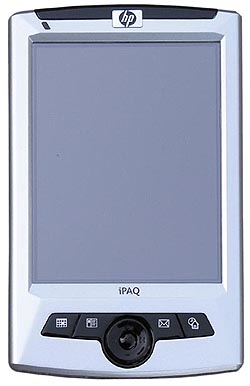 The 1700 uses the same Samsung S3C2410 that powered the 1900 Series. It's running at 203 MHz instead of 266 MHz in the 1900, and the new machine does feels a bit slower. Total RAM is just 32MB, of which the user can share 27.26 between storage and programs. An equally slender 10.33MB is available for iPAQ File Store backup. What this means is that rz1700 users should budget for a good-sized SD memory card. Fortunately, those now come in sizes up to 1GB, and with this new little machine meant to be a Mobile Media Companion, we suggest one of the bigger cards.
The 1700 uses the same Samsung S3C2410 that powered the 1900 Series. It's running at 203 MHz instead of 266 MHz in the 1900, and the new machine does feels a bit slower. Total RAM is just 32MB, of which the user can share 27.26 between storage and programs. An equally slender 10.33MB is available for iPAQ File Store backup. What this means is that rz1700 users should budget for a good-sized SD memory card. Fortunately, those now come in sizes up to 1GB, and with this new little machine meant to be a Mobile Media Companion, we suggest one of the bigger cards.
As a loss-leader, the rz1700 does not come with a cradle or a case. Instead, power is supplied via a moderately sized power brick with prongs on it. Its six foot cord then plugs into the 1700's USB/docking cable. Not the most elegant solution, and if you lose the USB cable you're out of luck as the 1700 does not have a separate power jack. It's either this cable combo, or an optional cradle. On the plus side, HP has been standardizing the docking/power connectors, so you can use several of the older power assemblies if you have some lying around.
There are really no bad displays anymore these days and the 1700's 3.5-inch transflective TFT does the job. It doesn't have the annoying yellow tint of the 1900's display. There is excellent contrast, and white backgrounds are just that, white. Viewing angles are acceptable, roughly on par with its predecessor.
1700 Series owners can choose from six Today themes, and under "Items" they can now also select "iPAQ Entertainment." This will start Today with a cool new HP launch screen with four entertainment/multimedia oriented icons. Being the Junior Mobile Media Companion of the bunch, the 1700 only offers two such destinations, HP Image Zone and the Windows Media Player. The other two icons lead to Schedule and Contacts. The screen utility panel lets you select the standard portrait plus landscape orientation for both left and right handed operation. Very cool. You can also vary text size in four increments, and turn ClearType on or off.
The main attraction is HP Image Zone, a cool application that lets you organize and manage pictures. You can zoom in and out, do slide shows, share pictures and all sorts of neat stuff.
The 1700 Series is inexpensive ($279) and competent enough, but the very meager onboard memory means that you'll have to spring for a hefty SD memory card. And a case, a cradle, and headphones because of the very low volume speaker. Also, no Bluetooth, camera, or WiFi. Bottomline: nice low price for a brand name product, but we wonder if you're not better off spending a bit more and get the fully loaded model.
Home entertainment: HP iPAQ rx3000 Series Mobile Media Companion
The rx3000 Series is for those who just can't come to terms with a something as basic as the 1700 which is missing a lot of what a true Mobile Media Companion should include. The new rx3715 looks like a fully equipped car compared to a stripped base model. It has 64MB of RAM onboard plus 96.5MB of file storage that can be used for backups and other purposes. It has internal Bluetooth as well as integrated 802.11b. There is a powerful (1,440 mAH) removable battery and you can get an optional 2,880 mAH battery that plugs right into the back of the unit. The rx3715 model even has a built-in 1.3 megapixel (1280 x 960 pixel) camera that carries the "hp photosmart' name, just as HP's lineup of digital cameras. There's a 4X digital zoom and you can even take movies with sound, albeit in a smallish 176x144 format. And the 3715 does come with a nice cradle, a set of pretty good stereo headphones, and a (basic) leather slip case.
 At 4.5 x 2.8 inches its footprint is roughly the same as the entry level model. It is also just a tenth of an inch thicker. All the extra goodies add a bit to the weight. The rx3715 weighs 5.6 ounces, about an ounce and a half more than the featherweight 1700.
At 4.5 x 2.8 inches its footprint is roughly the same as the entry level model. It is also just a tenth of an inch thicker. All the extra goodies add a bit to the weight. The rx3715 weighs 5.6 ounces, about an ounce and a half more than the featherweight 1700.
Overall, the rx3175 feels solid and very well designed and manufactured. It looks good, just not as exciting as some past iPAQs. All the controls are in the right place. The nav disc is a bit too small for my taste, as are the app buttons. It's an elegant arrangement, but gamers may not find suited to their needs. The camera is very nicely integrated into the bottom of the machine. There isn't a lens cap or any other protection for it, but it probably doesn't need one. There is no lid to protect the display, so you'll have to use the included slipcase or get a better third party case.
Software is where the rx3175 shines. Unlike the lesser 1715, all four of the "iPAQ Entertainment" icons connect to media-related apps. One goes to the camera application, the second to HP Image Zone, the third to HP Mobile Media, and the fourth to the Nevo universal home remote control. If you figure out how to use all this, the rx3175 can truly become your mobile media companion, and more. You'll be able to use it to take pictures, edit and print them, share and move them in various ways, and even use it as a universal remote control for just about all of your entertainment gear. Thanks to the built-in WiFi you can even stream and view content anywhere within reach of your wireless network, download and listen to music, and all of that on top of the usual communications tasks of a modern PDA, like sending and receiving email and browsing the web. Sound through the speaker is considerably louder than the nearly inaudible level of the rz1710. Stereo sound through the supplied headphones is sensational.
Printing used to be something most PDA users could only dream of. Yet now it's here. Once you've taken a photographic masterpiece you can send it to a suitable printer in three ways: via Bluetooth, via IR, or via your network.
The 3000 Series uses a Samsung S3SC2440 processor (no speed is given; HP wants to move away from speed ratings) that provides for decent performance. There is enough memory. Browsing the web works well, especially in landscape mode. Personally, I would have liked to see a higher resolution display in this relatively costly ($499) model.
All in all, the iPAQ rx3715 is a fine machine with superb connectivity and very interesting, entertaining software. For budget-conscious consumers who want a 3000 Series iPAQ, HP will have basic rx3115 with less memory and without the camera.
Best PDA ever: HP iPAQ hx4700 Pocket PC
The new hx4700 Pocket PC is the one everybody will be lusting after. If the 1700 Series is the loss leader that gets people into the showroom and the nicely equipped 3000 Series the one that most people will leave with, the 4700 Series is the sleek, luxurious high end model everyone wants but can't afford. Except that in this case, it IS affordable. The hx4700 costs just $150 more than the rx3715. For that money you get a handheld computer that sets new standards in every respect.
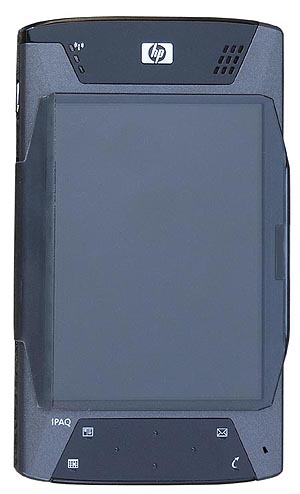 The hx4700's display is far and away the best in any PDA. It measures 4-inches diagonal and sports a full 480 x 640 resolution. That's almost 200 dots per inch. Most modern notebooks have less than 100 dots per inch. Combine that incredible resolution with Windows Mobile 2003 for Pocket PC, Second Edition's ability to higher resolutions and you have simply the best and sharpest display ever. This is the closest to writing or typing on crisp white paper I have ever seen on a screen. If you view images on this display, they are unbelievably sharp and lifelike even in high magnification.
The hx4700's display is far and away the best in any PDA. It measures 4-inches diagonal and sports a full 480 x 640 resolution. That's almost 200 dots per inch. Most modern notebooks have less than 100 dots per inch. Combine that incredible resolution with Windows Mobile 2003 for Pocket PC, Second Edition's ability to higher resolutions and you have simply the best and sharpest display ever. This is the closest to writing or typing on crisp white paper I have ever seen on a screen. If you view images on this display, they are unbelievably sharp and lifelike even in high magnification.
The 4700 looks considerably larger than the lesser models but still measures just 5.2 x 3 inches and is just 0.59 inches thick. The case looks like that of the 3000 Series, but represents another first. This iPAQ is made of magnesium alloy.
The hc4700 sports another novelty, and that is the first navigation touchpad. It looks just like a small version of a notebook touchpad, uses Synaptics "NavPoint" software, and works just like a notebook touchpad. The pad is flanked by four silkscreened application buttons that have microscopic nano-marker so that your fingers know where it is.
The 4700 is among the first devices to use Intel's new "Bulverde" PXA270 processor. And HP chose the fasted version, the 624MHz chip, for its new flagship. Needless to say, it flies. Total RAM memory is just 62.28 MB, but there is also an additional 85.06 MB of iPAQ file store. If that is not enough, the 4700 has both a SD/MMC and a CF Card slot.
On the software front, with the exception of HP Image Zone, it's all business. That's great except that the 4700 with all its speed and awesome display practically begs for all the cool multimedia software of the 3000 Series. Movies, streaming video, high res imaging, GPS and mapping, all that would be a natural for this magnificent device, yet HP primarily targeted the 4700 for business. In addition to the standard Pocket PC apps, the 4700 comes with Web Information Solution Inc.'s excellent Pocket Informant 5.0 that takes full advantage of the Second Edition's landscape mode. There are also Westtek's ClearVue PDF and ClearVue Presentation, a Bluetooth Phonemanager, HP Mobile Printing, and more.
The hx4700 is near perfect and by far the best Pocket PC ever. We've balked at the high prices of top-of-the-line Pocket PCs (and Sonys!) before. This one is worth every cent of it, and more.
First phone: HP iPAQ 6300 Pocket PC Phone
The long-awaited HP iPAQ 6300 is finally here. And while its official launch coincides with that of the 1700, 3000, and 4700 Series, that seems merely coincidental as the 6300 is a totally different animal. Unlike the former that replace existing lines with new, and in some cases very significantly improved products, the 6300 is a first for HP, the first Pocket PC Phone.
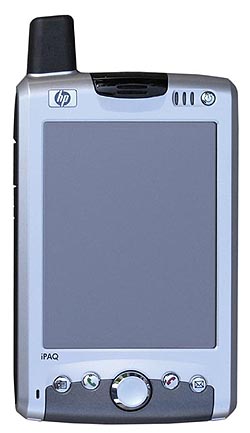 A lot of people will like the h6300 simply because it looks and feels so friendly and familiar. Anyone who's ever used an iPAQ will immediately know how to use it. There's the central nav disc flanked by the four application buttons. In this case, two are used for the phone. A green one starts the phone app or picks up a call. A red one ends it. There are rubber strips along each side of the device. On the left they incorporate the recording switch and a flap that covers the headphone jack. On the right you'll find the SD slot, volume increase and decrease, and the camera shutter. Like most Pocket PC Phones, the h6300 has a thick rubber-covered antenna nub that sticks out two thirds of an inch or so.
A lot of people will like the h6300 simply because it looks and feels so friendly and familiar. Anyone who's ever used an iPAQ will immediately know how to use it. There's the central nav disc flanked by the four application buttons. In this case, two are used for the phone. A green one starts the phone app or picks up a call. A red one ends it. There are rubber strips along each side of the device. On the left they incorporate the recording switch and a flap that covers the headphone jack. On the right you'll find the SD slot, volume increase and decrease, and the camera shutter. Like most Pocket PC Phones, the h6300 has a thick rubber-covered antenna nub that sticks out two thirds of an inch or so.
The h6300 also has a built-in digital camera. It can only take 640x480 pics, but that is still a lot better than most "cameras" built into cell phones. It also has both 802.11b wireless LAN and Bluetooth, making the h6300 a full 3-way wireless device that will never leave you stranded. Wherever you are, you can always pick from standard GSM phone service, GPRS data service, 802.11b high-speed service at home, in the office, or in one of the myriads of hotspots all over the place. And if all else fails, you can always give Bluetooth a try.
On the technology side, the h6300 retains the respectful distance from leading edge inherent to all Pocket PC Phones. Instead of a Bulverde CPU it has a workable TI OMAP 1510 chip that is fast enough. It does have a SD card slot, though, to complement the relatively meager 21MB of iPAQ File Storage. RAM itself is just fine, 64MB, of which 57 are available for programs and storage. The display is fine, too, and on par with those used in the new 1700 and 3000 series. Let's not forget that some of the earlier PPC Phones used 12-bit displays. The h6300 does 64k color. However, since the h6300 does not use the Second Edition additions, you can't rotate the display into landscape mode.
The h6300 comes with a dock that's designed to accommodate the device even with the extended battery, and there's an extra charging slot of a second battery, standard (1,800 mAh) or extended (3,600 mAh). The carry case that comes with the 6300 is one of those sideways leather clip-on-your-belts. It's big and bulky, and doesn't provide any access to the screen or even the answer buttons.
On the software side, HP went out of its way to offer as complete an experience as possible. In addition to the excellent phone interface you get AIM, Yahoo, and ICQ messaging clients. And since the 6320 model has the built-in camera, you also get HP's terrific camera application (which does work in landscape) and HP ImageZone.
Finally, for those who love keyboards, the h6300 can accommodate a snap-on thumbtype keyboard. It's specially designed for this model and has two large phone keys, green and red. The keys are round and stick out enough so you don't have to push down hard as is the case with some thumb-types.
Combine all that with a time-tested overall design that just plain works and you have a very attractive offering. With a list price of U$599.99 the h6300 is expensive, but what you end up paying will depend on the service plan.
Contact: Hewlett Packard www.hp.com
|

